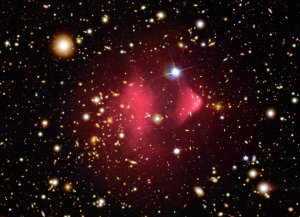© 2006 All Rights Reserved. Do not distribute or repurpose this work without written permission from the copyright holder(s).
Printed from https://danginteresting.com/the-dark-tale-of-colliding-superclusters/

For all that mankind has learned through science, the Universe has so far managed to keep most of its secrets. For instance, we don’t know where the Universe came from, what its fate will be, or even its most basic composition.
But over the last few decades, tantalizing clues and some very intelligent guesswork led astronomers to an astounding hypothesis: the ordinary matter that stiffens our bones and fuels our suns plays only a bit part in the grand epic of existence. Astronomers now believe that for every kilogram of normal matter like atoms, electrons, and quarks there are five kilograms of dark matter.
Very recently, astronomers announced what many had thought impossible, the direct observation of the existence of dark matter. Billions of years ago, two galactic superclusters collided. The collision occurred at a relative velocity of over a million miles per hour. Not since the Big Bang itself has the known universe experienced so violent an event. The aftermath of this collision offered what may be a once-in-Creation opportunity to finally “see” dark matter itself.
Ordinary matter is organized into structures from scales as small as the nucleus of an atom to those that span much of the Universe. The same four physical forces that bind protons to neutrons and hold our feet to the ground cause suns to organize into galaxies, galaxies to group into clusters, clusters to gather as superclusters, and superclusters to form structures astronomers call simply filaments, bubbles, and sheets.

Superclusters can contain millions of galaxies in relative close proximity. The stars within these superclusters remain bound to their native galaxies, but most of the gases are diffused throughout the cluster and heated to millions of degrees in the process. These gases make up most of the mass of an individual galaxy, and about 90% of the visible mass of the supercluster.
Astronomers have long been aware that superclusters do not contain enough visible matter to explain their existence. The hot gases and galaxies orbit the cluster so quickly that the gravity of the visible mass is insufficient to hold the matter together. Thus the theory of dark matter was born. The theory suggests that dark matter interacts with normal matter via only one of the four fundamental forces: gravity. Calculations and computer simulations show that clumps of dark matter lie at the centers of all large structures in the Universe, even the Milky Way.
When two clusters collide at high speeds, the visible galaxies and dark matter pass right by each other as if nothing happened. But the gases smash into each other with enough force to slow them down considerably. Thus most of the visible matter in the clusters is stripped away leaving two remnant clumps of dark matter behind. This is exactly what astronomers believe happened billions of years ago in cluster 1E0657-56, also called the bullet cluster.
The image at the top shows the bullet cluster in both visible light and X-rays. The fuzzy red light is the X-ray glow of the stripped gases. To the right and left of that glow you can see the clusters of galaxies themselves. This animation attempts to show the collision and better explain the images as well.

Intense gravitational fields warp the fabric of space-time enough to bend light rays. At galactic scales, this can cause a phenomenon called “gravitational lensing” that focuses and distorts the light we see from distant galaxies. By measuring this distortion, scientists can calculate both the mass and extent of the lensing object. The illustration on the left shows how the images of distant galaxies are brightened, distorted, and duplicated by gravitational lensing.
To the right and left of the bullet cluster, astronomers observed two very large gravitational lenses using the Hubble telescope. The mass necessary to create such large gravitational lenses (shown in blue in the picture on the right) is far greater than that of the galaxies in the original clusters, therefore something very massive and invisible lies at the center of those clusters. That something, observed now directly for the first time, is dark matter.

If that all seems a bit less than a direct observation, just consider the bottom line: something completely invisible that is nevertheless more massive than a cluster of galaxies and spans millions of light years is distorting the light from behind the bullet cluster. We don’t yet know what the dark matter is, but we now know it’s there. Whether dark matter is simply the husks of failed stars, some exotic new sub-atomic particle, or something else entirely is a secret the Universe still holds from us.
© 2006 All Rights Reserved. Do not distribute or repurpose this work without written permission from the copyright holder(s).
Printed from https://danginteresting.com/the-dark-tale-of-colliding-superclusters/
Since you enjoyed our work enough to print it out, and read it clear to the end, would you consider donating a few dollars at https://danginteresting.com/donate ?